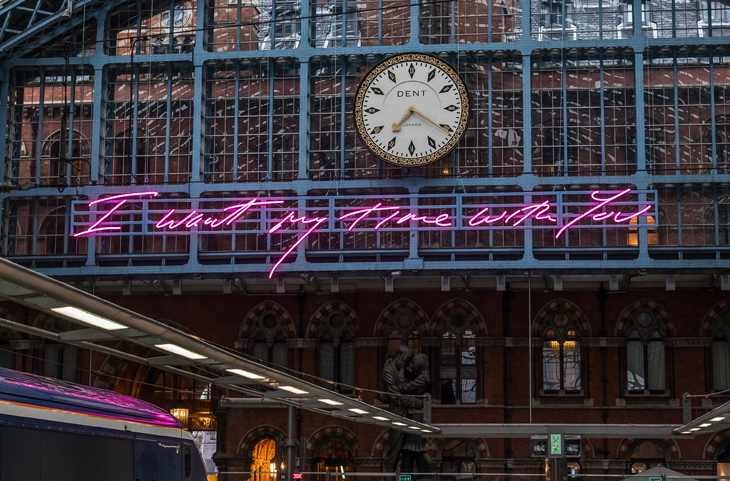London’s St Pancras station is a Victorian cathedral of redbrick and iron. For a spell in the mid 20th century, it decayed and was almost demolished – in 1949, the poet John Betjeman feared that it was ‘too beautiful and too romantic to survive’ – but eventually, after an £800 million investment, it was reborn as the British terminal of the Eurostar. Paris is 306 miles down the line. Here in this colossal vaulted space, two countries are meeting and parting ways.
The station is the site of Tracey Emin’s new installation, a single-sentence text: ‘I want my time with you’. These 18 letters are written in 20 metres of pink neon, one of Emin’s staple materials; the handwriting is her own too, her characteristic swift strokes. I Want My Time With You hangs from the wires above the Grand Terrace, and it’s visible from most of the station’s first floor, but since it’s square-on to the Eurostar platforms, it addresses directly the travellers either leaving for Europe or coming back home. Hanging in the concourse where people reunite after months apart, Emin’s words make their intimate feelings a public thing.
In this little romance, who’s the ‘I’, who’s the ‘you’? They might be individual lovers, anonymised in grammar. Or, poised where they are, they could be abstractions, political entities: ‘I’, facing down the line to France, the 48 per cent of British voters who didn’t want to sunder themselves from Europe; and ‘you’ the continent they’re being told to quit. For most of us, it could be both – the personal and the political – because ‘I want my time with you’ is a piece of speech, and the meanings of speech start to messily proliferate when feelings are involved. The neon gives tangible form to emotion, and amplifies it with light.
Emin has been making neon works since the early 1990s, and most of them end in one of two personal pronouns, either ‘me’ or ‘you’. Usually her words are unadorned by anything except an emphatic stroke; she puts People Like You Need to Fuck People Like Me (2007) in a doe-eyed loop, and gives I Can’t Believe How Much You Loved Me (2012) a double underscore. Each light-tube shows what Roger Fry saw in every calligraphic mark: ‘the record of a gesture’. And Emin adores neon’s sensual edge, calling it ‘sexy’, ‘spangly’, ‘pulsating’, ‘out there’, ‘vibrant’. In her strokes, you see the trace of her body itself.
Photo: Tim P. Whitby/Getty Images for HS1 St Pancras

I Want My Time With You is nakedly honest. That’s all the more obvious when you compare it to the permanent work on the Grand Terrace beneath: Paul Day’s The Meeting Place, a large bronze statue of two lovers united again. Train stations may be sanctuaries of romance, but every romance feels, to those who share it, like a unique and private dream; Day’s sculpture is postcard kitsch, a pose from the blandest of imaginations, and it’s been widely derided for years. Emin’s words aren’t a saccharine feel-good piece, but an exposure of something uncertain and raw. She says she imagines a question mark at the end of her sentence: ‘I want my time with you?’
When I went up to St Pancras to see Emin’s installation, London had been under thick cloud all week; we hadn’t seen the sun for days. With little light coming through the station’s vast roof, by mid-afternoon I Want My Time With You was starting to glow. By 8 o’clock night had fallen, and the words were burning in the air. Their brightness suddenly gave them thrust; it was as if they were pushing away from the brickwork behind. In the book Flickering Light: A History of Neon, Christoph Ribbat tells a story from 2010, about Emin going back to Margate to open the Turner Contemporary gallery: ‘She appeared in front of the Margate Pier and Harbour Company Building, now adorned with a pink-coloured neon installation featuring Emin’s characteristic handwriting and the words ‘I’ve never stopped loving you’. […] Taking hold of the microphone to give a speech on that spring day, with the audience eager before her and her glowing pink declaration of love to crisis-ridden Margate overhead, Tracey Emin burst into tears.’
Picture I Want My Time With You the same way: the handwritten trace of a woman, leaning forward, imploring a crowd, or a country, or a single person who’s about to leave her. Once you imagine how any of that might feel, you understand what neon gives Emin. She could write a ‘declaration of love’ in ink or paint; anyone could. But romance is a thing with aura, and it needs a certain glow.



